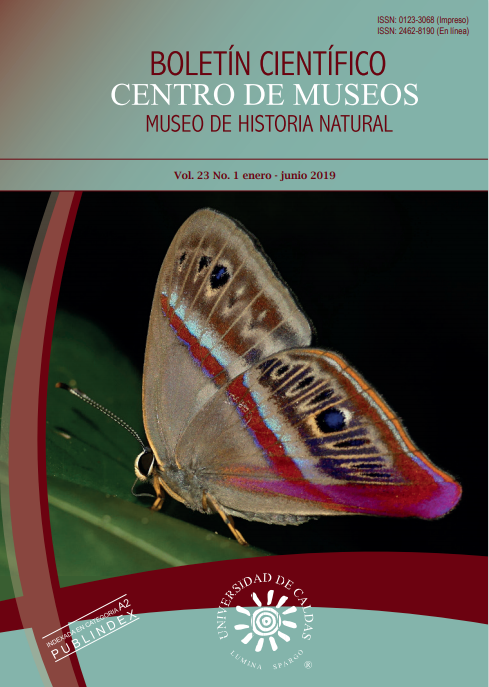Authors
Abstract
Introduction. Obesity is the excessive increase of adipose tissue in the body which is considered a disease that, in the last two decades, has been affecting about 50% of the dog population worldwide. Objective.This research aimed to provide scientific information on the prevalence of canine obesity in Manizales and identify some risk factors. Methodology. An epidemiological
study of obese canines was carried out at the Diego Villegas Toro Veterinary Hospital in the city of Manizales, Department of Caldas. A total of 1,060 cases were collected from January to June 2017. Body condition, on a scale of 1 to 9, was evaluated to determine the degree of obesity. The body condition and obesity degree were analyzed according to breed, gender and age. Results. The 24.40% of canines present some degree of obesity. The most obese breeds are Beagle (57.14%), Labrador (46.00%) and Pinscher (27.03%). The adult dogs followed by the senile dogs are the most obese. There is a statistical association between body condition and the breed (p=0.001) and age (p=0.001) variables, but there is not statistical association between body condition and gender (p = 0.30). Statistical association was found of obesity with the breed (p=0.05), age (p=0.007) and gender (p=0.002). Prevalence of obesity was
lower than that reported in countries such as the United States, France, China and Spain. Conclusions. The breed and the age are risk factors for the appearance of obesity. Beagle, Labrador, Pinscher, Pitbull, Poodle and Mestizo breeds are the most susceptible to obesity as well as adult animals, followed by senile dogs. It is important to carry out research on the prevalence in other regions of the country.
Keywords
References
BARTGES, J., KUSHNER, R.F., MICHEL, K.E., SALLIS, R. & DAY, M.J., 2017.- One Health Solutions to Obesity in People and Their Pets. J. Comp. Path., 156: 326-333.
BURKHOLDER, W.J. & BAUER, J.E., 1998.- Foods and techniques for managing obesity in companion animals. J. Am. Vet. Med. Assoc., 212(5): 658-662.
BURKHOLDER, W.J. & TOLL, P., 2000.- Obesity: 401-430 (en) HAND, M., THATCHER, C. & REMILLARD, R. (eds.) Small Animal Clinical Nutrition. Topeka: Mark Morris Institute.
BURKHOLDER, W.J. & TOLL, P., 1996.- Changes in body composition and energy balance with aging. Veterinary Clinical Nutrition, 3: 83-87.
CASSIDY, K.M., 2010.- Reported measures of how long dogs live. Dog longevity. Disponible en: https://sunsongdachshunds.wordpress.com/2010/12/13/dog-longevity/.
COLLIARD, L., ANCEL, J., BENET, J-J., PARAGON, B.M. & BLANCHARD, G., 2006.- Risk factors for obesity in dogs in France. The Journal of Nutrition, 136: 1951S-1954S.
CORBEE, R.J., 2013.- Obesity in show dogs. J. Anim. Physiol. Anim. Nutr., 97(5): 904-910.
CORTÉS, R.I., 2008.- Perfil epidemiológico de los caninos y felinos en tres clínicas veterinarias de Manizales: Tesis, Facultad de Medicina Veterinaria, Universidad de La Salle, Bogotá.
CRANE, S.W., 1991.- Occurrence and management of obesity in companion animals. J. Small Anim. Pract., 32: 275-282.
EDNEY, A.T. & SMITH, P.M., 1986.- Study of obesity in dogs visiting veterinary practices in the United Kingdom. Veterinary Record, 118: 391-396.
GERMAN, A.J., 2006.- The growing problem of obesity in dogs and cats. J. Nutr., 136: 1940S-1946S.
GERMAN, A.J., 2011.- Canine obesity weighing in the mind of the owner? J. Small Anim. Pract., 52: 619-620.
GERMAN, A.J., 2016.- Obesity Prevention and Weight Maintenance After Loss. Vet Clin Small Anim., 46(5): 913-929.
GONZÁLES, D.M. & BERNAL, L., 2011.- Diagnóstico y manejo de la obesidad en perros: una revisión. CES Medicina Veterinaria y Zootecnia, 6(2): 91-102.
JEUSETTE, I., GRECO, D., AQUINO, F., DETILLEUX, J., PETERSON, M. & ROMANO, V., et al., 2007.- Effect of breed on body composition and comparison between various methods to estimate body composition in dogs. Research Veterinary Science, 88(2): 227-232.
KEALY, R.D., LAWLER, D.F., BALLAM, J.M., MANTZ, S.L., BIERY, D.N. & GREELEY, E.H., et al., 2001.- Effects of diet restriction on life span age-related changes in dogs. Journal of the American Veterinary Medical Association, 220: 1315-1320.
MAO, J., ZHAOFEI, X., JIANGNAN, C. & JINHAI, Y., 2013.- Prevalence and risk factors for canine obesity surveyed in veterinary practices in Beijing, China. Preventive Veterinary Medicine, 112(3-4): 438-442.
LAFLAMME, D.P., 1997.- Development and Validation of a Body Condition Score System for Dogs. Canine Practice, 22(1): 10-15.
LAFLAMME, D.P., 2001.- Challenges with weight-reduction studies. Compend. Contin. Educ. Pract. Vet., 23: 45-50.
LUND, E.M., ARMSTRONG, P.J., KIRK, C.A. & KLAUSNER, J.S., 2006.- Prevalence and risk factors for obesity in adult dogs from private US veterinary practices. Intern. Journal. Appl. Res. Veterinary. Medicine, 4: 177-186.
MASON, E., 1970.- Obesity in pet dogs. Vet. Rec., 86: 612-616.
MCGREEVY, P.D., THOMSON, P.C., PRIDE, C., FAWCETT, A., GRASSI, T. & JONES, B., 2005.- Prevalence of obesity in dogs examined by Australian veterinary practices and the risk factors involved. The Veterinary Record, 156: 695-702.
MONTOYA-ALONSO, J.A., BAUTISTA-CASTAÑO, I., PEÑA, C., SUÁREZ, L., CANDELARIA JUSTE, M. & TVARIJONAVICIUTE, A., 2017.- Prevalence of Canine Obesity, Obesity-Related Metabolic Dysfunction, and Relationship with Owner Obesity in an Obesogenic Region of Spain. Front. Vet. Sci., 4: 59.
PARKER, H.G., KIM, L.V., SUTTER, N.B., CARLSON, S., LORENTZED, T.D. & MALEK, T.B., et al., 2004.- Genetic structure of the purebred domestic dog. Science, 304(5674): 1160-1164.
SCARLETT, J.M., DONOGHUE, S., SAIDLA, J. & WILLS, J., 1994.- Overweight cats: Prevalence and risk factors. International Journal of Obesity, 18(Suppl. 1): S22-S28.
SERVIDDIO, R., 2009.- Obesidad canina. Buenos Aires: Universidad Nacional de La Plata.
ZORAN, D.L., 2010.- Obesity in dogs and cats: A metabolic and endocrine disorder. Vet. Clin. North Am. Small Anim. Pract., 40: 221-239.

 PDF (Español)
PDF (Español)
 FLIP
FLIP






















